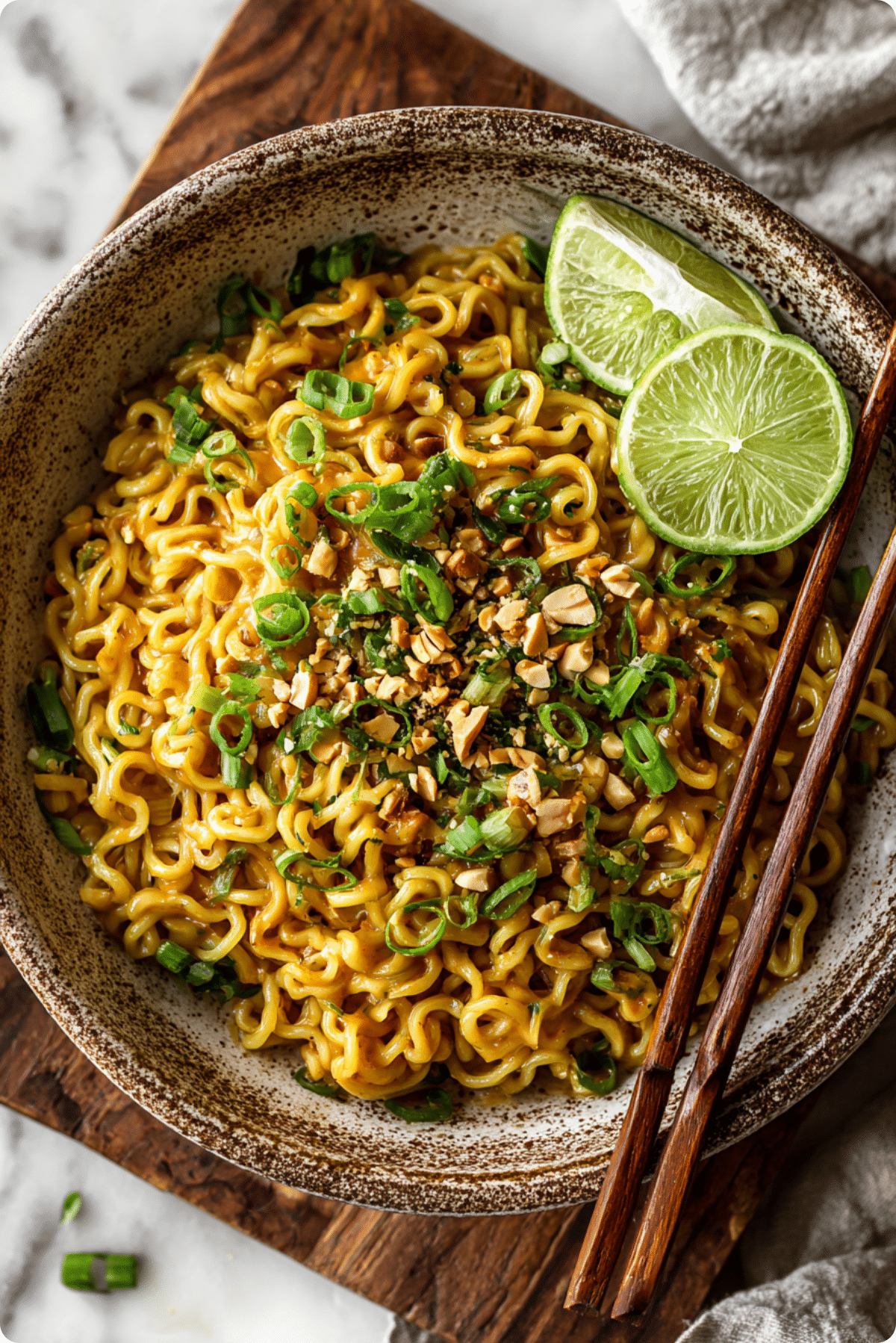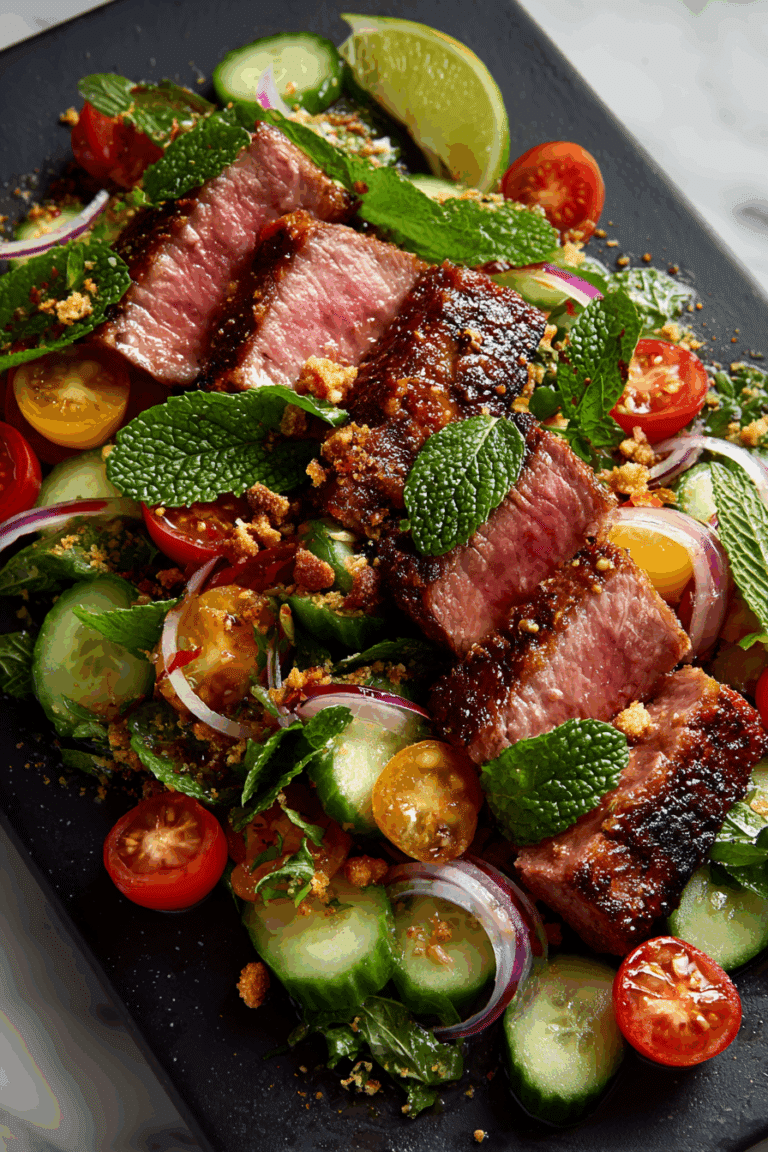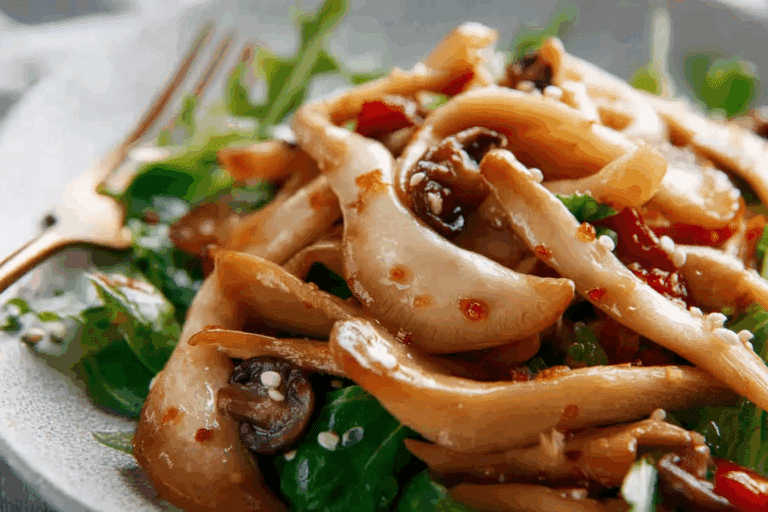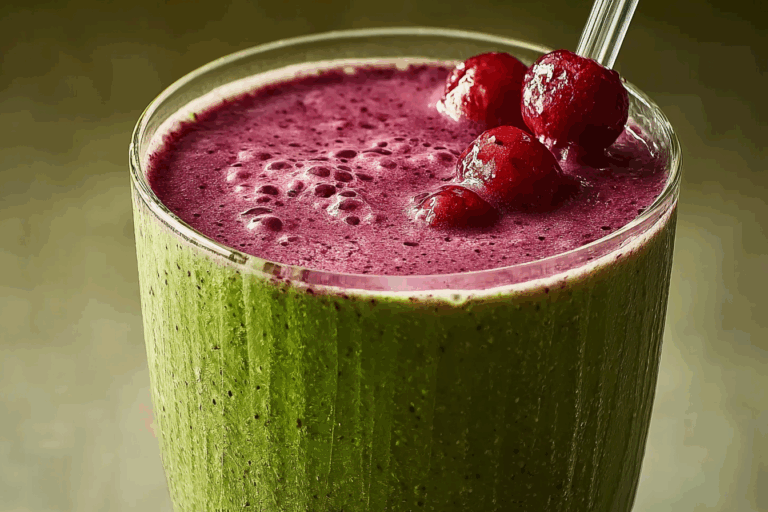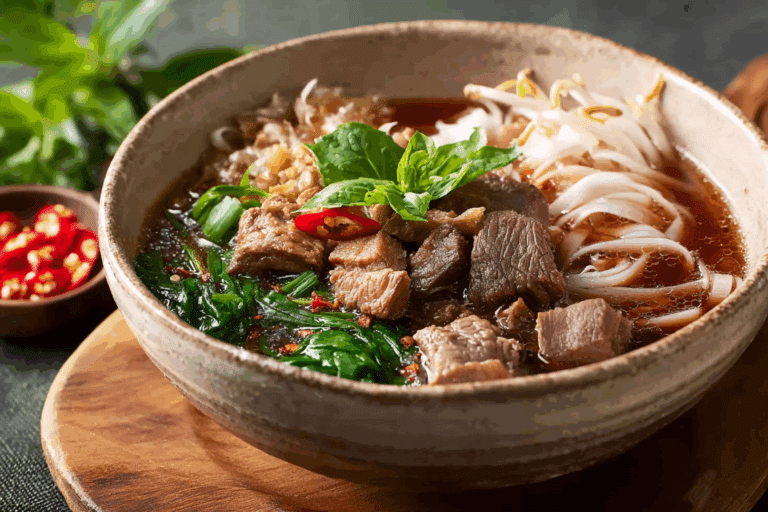The Best Thai Peanut Butter Ramen Recipe You’ll Ever Try
Thai Peanut Butter Ramen might sound like an unexpected fusion, but once you taste it, you’ll understand why this creamy, savory, slightly spicy noodle dish has taken over food blogs and TikTok feeds everywhere. Before diving into this cozy bowl of comfort, let me tell you a little about how it became a favorite on my table and on Just Thai Recipes, where I share everything from classic Thai curries to quick noodle bowls like this one.
When I first started Just Thai Recipes, it was a small space to share my grandmother’s recipes. She grew up in northern Thailand, where food is a celebration of balance salty, sweet, sour, and spicy all in one bite. My goal was to bring that same balance to easy, modern meals that anyone could make at home. I wanted to show that Thai food is not intimidating, it’s just a beautiful combination of fresh ingredients and bold flavors.
The story behind Thai Peanut Butter Ramen is simple and kind of funny. One night, after a long day of shooting recipes for the blog, I craved something creamy, spicy, and quick. I had ramen noodles, peanut butter, and a jar of Thai red curry paste sitting in my pantry. I tossed them together with coconut milk, a few vegetables, and some chicken slices. Within fifteen minutes, I had something so comforting and flavorful that I knew it had to be shared on the site. That was the first time I realized how peanut butter could add an irresistibly rich texture to Thai-style noodles.
If you’ve ever had Spicy Peanut Ramen Noodles or 30 Minute Crispy Thai Peanut Chicken Ramen, you’ll understand how that combination of silky broth and chewy noodles hits the spot. But this particular Thai Peanut Butter Ramen recipe stands out because it’s not just a simple noodle bowl, it’s a fusion of pantry staples and Thai comfort flavors that makes dinner feel indulgent yet easy.
In this post, I’ll walk you through every detail, from the Thai Peanut Butter Ramen ingredients to step-by-step instructions, plus a few pro tips for perfecting the creamy texture and spicy balance. Whether you’re cooking for yourself, your family, or even trying to impress someone with your cooking skills, this recipe is guaranteed to make them smile.
Before you know it, this will become your new weeknight favorite. And if you’re new to Just Thai Recipes, welcome. You’ll find everything here made with love, tested in a home kitchen, and shared with the same warmth Thai food is known for.
Table of Contents
Table of Contents
Ingredients for Thai Peanut Butter Ramen
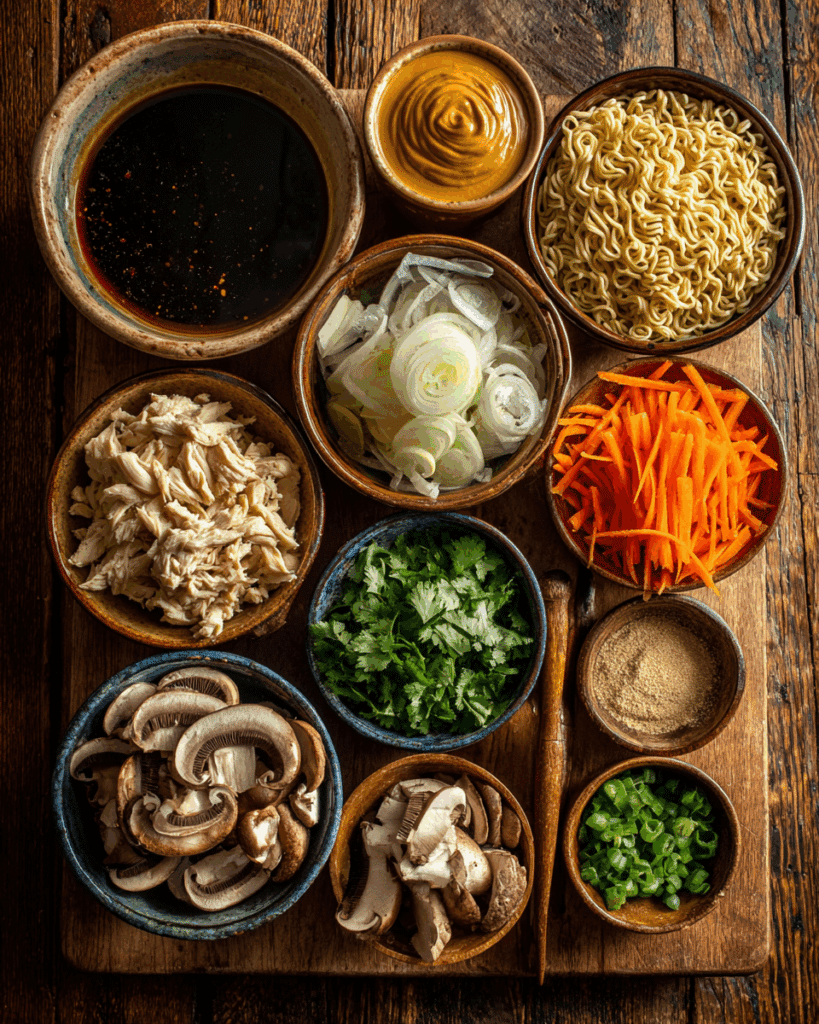
This Thai Peanut Butter Ramen recipe uses simple pantry-friendly ingredients that combine to create an authentic yet modern Thai-style flavor. Each ingredient adds its own charm, from the creamy coconut base to the savory soy sauce and nutty peanut butter that ties everything together.
Here’s what you’ll need:
- ½ cup coconut milk – This forms the rich, velvety base of the soup. Use full-fat coconut milk if you want a creamier result. Light coconut milk also works but gives a lighter consistency.
- ½ tablespoon red curry paste – This is the backbone of flavor. It brings heat, garlic, lemongrass, and that deep Thai essence. You can find it in the Asian aisle of most grocery stores.
- 4 tablespoons creamy peanut butter – This is the soul of the dish. It gives the ramen its signature nutty flavor and creamy texture. Smooth peanut butter works best, but natural varieties can be used too.
- 1½ cups water – Used to thin the sauce into a broth-like texture while helping the noodles cook evenly.
- 1 tablespoon Rosdee seasoning powder – A common Thai flavor enhancer that adds a touch of savory umami. If you can’t find it, chicken bouillon powder or mushroom seasoning can be substituted.
- 1 tablespoon light soy sauce – Adds depth and saltiness while balancing the sweetness of the coconut milk.
- ½ cup chicken, sliced thinly – Tender strips of chicken cook quickly and soak up all the flavors. You can use leftover rotisserie chicken for convenience.
- ¼ cup onion, sliced thinly – Adds a slight sweetness and crunch when cooked.
- ¼ cup carrot, sliced thinly – A splash of color and subtle sweetness that pairs beautifully with the nutty broth.
- ½ cup mushrooms – Shiitake or oyster mushrooms are ideal, but any variety will work. They absorb the flavors and add that perfect earthy tone.
- 1 pack instant ramen noodles – You can use any flavor since you’ll discard the seasoning packet. The noodles are simply a vessel for the creamy, spicy sauce.
- 1 tablespoon coriander, chopped – Optional garnish, but it adds a fresh, herbal touch.
- 1 green onion, chopped – Another optional garnish for extra crunch and a pop of color.
Notes and Ingredient Swaps
If you don’t have Rosdee powder, you can easily swap it for chicken stock cubes or even fish sauce for a more traditional Thai taste. For a vegetarian twist, replace chicken with tofu or tempeh and use vegetable broth instead of Rosdee seasoning.
The Thai Peanut Butter Ramen ingredients are highly flexible. You can add extra vegetables like bell peppers, zucchini, or spinach if you want to make it heartier. You can also replace peanut butter with almond or cashew butter for a different nutty flavor.
For spice lovers, add a teaspoon of chili flakes or a drizzle of sriracha to bring even more heat. The balance of sweet, salty, spicy, and creamy is what makes Thai Peanut Butter Ramen so irresistible, so feel free to adjust the seasoning until it matches your personal taste.
Step-by-Step Instructions for Making Thai Peanut Butter Ramen
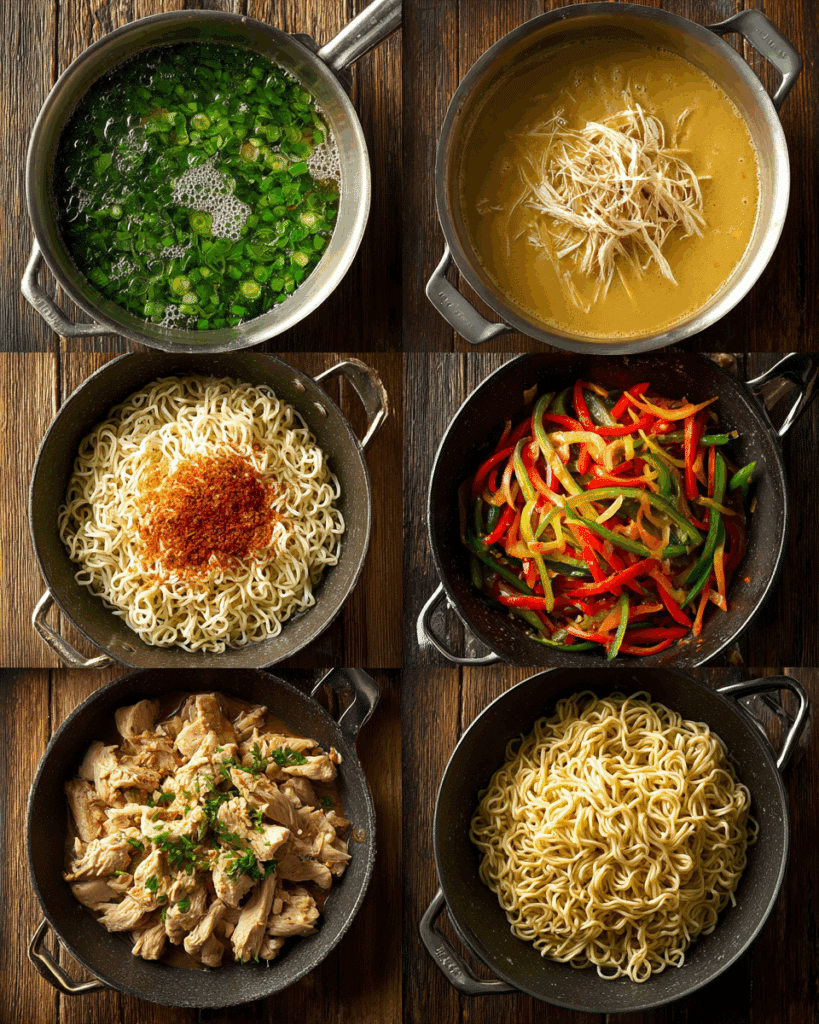
Cooking Thai Peanut Butter Ramen is wonderfully simple, but getting the texture and flavor balance right is key. The creamy peanut butter and coconut milk need to come together perfectly, creating that smooth, comforting broth that coats every strand of ramen.
Here’s how to do it:
Step 1: Build the Base
Place a medium-sized pot or wok over medium heat. Pour in the coconut milk and let it warm up until it begins to shimmer. Add the red curry paste and peanut butter, stirring continuously until the mixture becomes smooth and fragrant. You’ll notice a glossy sheen on the surface, which means the coconut oil has separated slightly and everything is blending together beautifully.
Step 2: Add the Liquids
Pour in the water, soy sauce, and Rosdee seasoning powder. Stir gently to combine everything and let it come to a gentle boil. This step ensures that the salty and savory elements are evenly distributed throughout the broth.
Step 3: Cook the Chicken
Add the sliced chicken pieces. Stir occasionally and cook until the chicken turns opaque and no longer pink. Because the slices are thin, this should take only a few minutes.
Step 4: Add the Vegetables and Noodles
Once the chicken is cooked, toss in the onions, carrots, and mushrooms. Immediately after that, add the ramen noodles. Cook everything together until the noodles soften and the vegetables are tender. Be careful not to overcook or let the noodles soak up all the liquid. The sauce should remain creamy and slightly thick, clinging to the noodles.
Step 5: Taste and Adjust
Before serving, taste your Thai Peanut Butter Ramen. Adjust the seasoning if needed by adding a bit more soy sauce for saltiness or a small spoon of peanut butter for richness.
Step 6: Serve and Garnish
Ladle the ramen into bowls while hot. Top with freshly chopped coriander and green onions. If you like, sprinkle crushed peanuts or drizzle a little chili oil for extra flair.
Cooking this Thai Peanut Butter Ramen recipe is as easy as it is rewarding. The entire process takes less than 20 minutes, making it a perfect quick dinner for busy nights. The creamy broth, tender chicken, and chewy noodles combine into one comforting bowl that hits every craving at once.
For a similar idea, you can explore recipes like this 20 Minute Thai Peanut Chicken Ramen or the classic All Recipes Thai Peanut Butter Ramen. Both show how versatile peanut and curry-based noodles can be, each with a slightly different twist.
Once you’ve made this dish a few times, you’ll probably start experimenting maybe swapping chicken for shrimp, or adding crispy tofu. That’s the beauty of Thai Peanut Butter Ramen. It’s flexible, forgiving, and endlessly satisfying.
Tips and Tricks for Perfect Thai Peanut Butter Ramen
When you make Thai Peanut Butter Ramen at home, you want that deep, creamy, punchy flavor that tastes like something from a cozy Thai noodle bar, but with the comfort of a fast weeknight dinner. This section is all about how to get the best results every single time. I am going to walk you through texture, heat level, timing, and even how to fix it if something goes a little off. Because honestly, Thai Peanut Butter Ramen is very forgiving, which is part of why people keep coming back to this recipe.
Control the creaminess. The creaminess of Thai Peanut Butter Ramen mainly comes from the coconut milk and the peanut butter. If you like a thicker noodle sauce that really clings to the ramen instead of acting like a soup, you can simply simmer the coconut milk, red curry paste, and peanut butter a little longer in the first stage before adding the water.
The longer you simmer it, the more it reduces and concentrates. This gives Thai Peanut Butter Ramen a richer, almost satay-like feel. If you prefer a looser broth, which is more like a spicy peanut ramen noodle soup, just add a splash more water or even a bit more coconut milk toward the end. The great part is, there is no wrong answer. It is just personal style.
Use good peanut butter. Smooth, creamy peanut butter makes Thai Peanut Butter Ramen velvety and balanced. Natural peanut butter works well, but stir it first so the oil is blended into the peanut paste. If you toss in un-stirred natural peanut butter, you sometimes get oil separation in the pot. That is not a disaster, but it can make the broth look a bit broken. You can fix it by whisking a little hot broth in a cup with more peanut butter, then slowly stirring that back into the pot. That trick will bring Thai Peanut Butter Ramen back together and make it glossy again.
Taste the salt level before serving. People are surprised that Thai Peanut Butter Ramen does not always need extra salt, because ingredients like soy sauce and Rosdee seasoning powder are already savory. Before you salt anything, taste. If you want more salt, add a tiny splash more light soy sauce, not table salt. Soy sauce blends in better and tastes rounder here.
Add sweetness if you need balance. Classic Thai flavor is about balancing salty, creamy, spicy, and a touch sweet. Sometimes your Thai Peanut Butter Ramen will be almost perfect, but it just needs that last little note to make it feel restaurant balanced.
You can add a half teaspoon of brown sugar or even a small squeeze of honey. It helps bring out the peanut butter and coconut milk and gives the noodles a warmer, deeper flavor. This is especially nice if you added extra red curry paste or chili and the dish skewed more spicy.
Cook the noodles last and do not walk away. When ramen noodles sit in hot liquid, they keep soaking. If you leave Thai Peanut Butter Ramen on the stove for too long after adding the instant ramen, the noodles will get puffy and soft, and they might pull in all the saucy broth. That is why we add the noodles toward the end, cook them until just tender, and serve right away. If you like a little chew, take the noodles off the heat 30 seconds before you think they are done. The residual heat in the pot will finish them.
Slice the chicken thin. Thin chicken cooks fast and evenly, and it absorbs flavor better. When you add thin slices of chicken directly into the broth for Thai Peanut Butter Ramen, it slowly poaches in that seasoned peanut coconut curry base. This keeps it tender and juicy instead of dry. Thick chunks of chicken are more likely to turn rubbery unless you cook them separately first. So if you can, slice the chicken into thin strips against the grain. It makes a big difference in the final bite of Thai Peanut Butter Ramen.
Use mushrooms for depth. Mushrooms are not just a filler ingredient here. They add earthy depth and a savory quality that makes Thai Peanut Butter Ramen taste more developed, almost like it simmered for longer than it really did. Shiitake, oyster, or even basic button mushrooms absorb the peanut curry broth and become little flavor bombs.
Bright garnish matters. Fresh coriander and green onion on top might seem like decoration, but they wake up the bowl. Thai Peanut Butter Ramen is rich and creamy, which can feel heavy if you do not add that pop of herbal freshness at the end. The green onion and coriander balance it and keep it tasting alive. You can also add a squeeze of lime right before eating if you enjoy a little citrus pop.
Spice level tips. If you like mild heat, stick with the base amount of red curry paste. If you like your Thai Peanut Butter Ramen on the fiery side, you have options. You can stir in fresh chili slices, chili crisp, or sriracha at the end. You can also add some crushed red pepper while the broth is simmering so the heat infuses. For a slow-building heat that lingers on the lips, a small spoon of chili oil on top of your Thai Peanut Butter Ramen bowl right before serving is perfection.
Meal prep tip for busy nights. You can pre slice the onion, carrot, mushrooms, and chicken and store them in containers in the fridge so that cooking Thai Peanut Butter Ramen on a weeknight takes 10 minutes. When everything is prepped, you basically just layer ingredients into the pot in the correct order and let the noodles finish. It is faster than takeout and tastes honestly better.
Let your nose guide you. The moment the coconut milk, red curry paste, and peanut butter start melting together, you will smell when it is ready. It will go from smelling like separate things to smelling like Thai Peanut Butter Ramen. That is when the oils are coming out and the curry paste is blooming, and at that point you know the base flavor is strong enough to move forward with water and soy sauce.
If you follow these little tricks and cook with intention, your Thai Peanut Butter Ramen will turn out creamy, balanced, and deeply comforting every single time.
Variations on Thai Peanut Butter Ramen
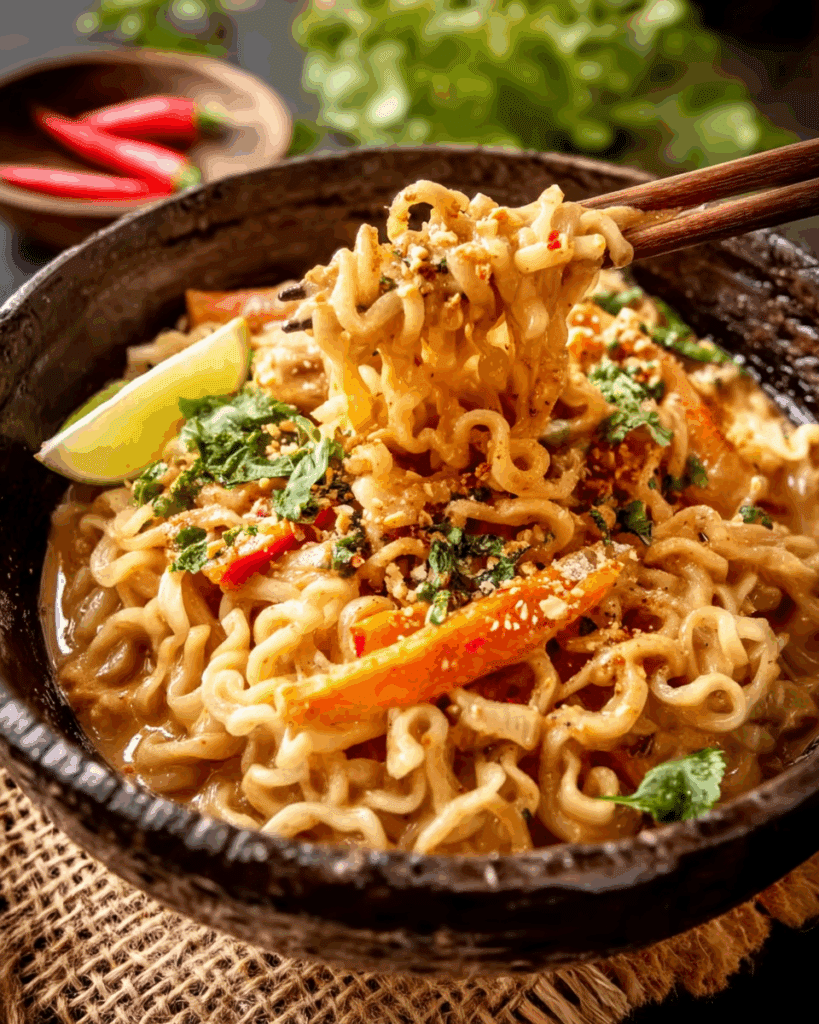
One of the most exciting things about Thai Peanut Butter Ramen is how easy it is to customize. You can change the protein, adjust the spice level, bulk it up with vegetables, or even turn it into more of a soup style bowl or a thicker noodle stir fry style bowl. I will walk you through some favorite variations that people ask for when they search for Thai Peanut Butter Ramen recipe, 30 Minute Crispy Thai Peanut Chicken Ramen, and spicy peanut ramen noodles.
Crispy chicken version. If you have seen 30 Minute Crispy Thai Peanut Chicken Ramen or something like that, you already know how addictive crispy chicken on noodles can be. To get that vibe, instead of simmering raw sliced chicken right in the broth, you can pan fry or air fry chicken pieces separately first. Lightly toss thin chicken strips with a little cornstarch, salt, and pepper. Cook them in a bit of oil until golden and crisp on the edges.
Then make the Thai Peanut Butter Ramen broth as usual without the chicken, and add the crispy chicken on top right before serving. You get texture contrast, which is really satisfying. The creamy peanut coconut base hugs the crunchy edges of the chicken. This version feels a little indulgent, and it photographs beautifully.
Shrimp or seafood version. If you are not in the mood for chicken, Thai Peanut Butter Ramen is incredible with shrimp. Clean and devein medium shrimp, then add them to the simmering broth after you add the liquids. Shrimp cooks really fast, usually in two to three minutes, so do not add them too early.
The natural sweetness of shrimp pairs beautifully with the peanut butter and coconut milk, and it gives the ramen a slightly more Thai street food personality. You can also try a mix of shrimp and mushrooms, which gives Thai Peanut Butter Ramen a surf and earth balance that tastes surprisingly expensive, even though it is still budget friendly.
Vegetarian or vegan version. You can absolutely make Thai Peanut Butter Ramen plant based. Swap the chicken for cubed tofu or tempeh. Use vegetable broth or a plant based seasoning powder instead of Rosdee chicken style seasoning.
Use light soy sauce or tamari to keep it friendly for most diets. Mushrooms should stay in, since they create body and richness. You can also add bok choy, spinach, or snap peas in the last minute of cooking for color and crunch. This version of Thai Peanut Butter Ramen is high in plant protein and healthy fats, and people genuinely love how filling it is.
Extra vegetable version. If you are the kind of person who wants to sneak in more vegetables but still craves something cozy and comforting, Thai Peanut Butter Ramen makes it super easy. You can double the carrot and onion, add thin red bell pepper slices, toss in baby corn, or throw in a handful of shredded cabbage. These vegetables soak up the broth and help make the bowl more colorful and nutrient dense. A veggie loaded bowl of Thai Peanut Butter Ramen is a great way to make the dish feel more dinner worthy and less like a late night college survival trick.
Extra spicy version. A lot of people who find Thai Peanut Butter Ramen through peanut butter ramen TikTok are spice lovers. To make it extra spicy, you can increase the red curry paste, stir in sambal, or top the final bowl with chili crisp. Another move is to add a spoon of Thai chili paste or a little fish sauce and fresh minced chili for that deeper heat that hits the back of the throat. This creates more of a spicy peanut ramen noodles experience that wakes you up.
Soupy versus saucy. Some people like Thai Peanut Butter Ramen to eat like ramen soup, and others like it thick, almost like peanut stir fry noodles. To get a soupier version, add an extra half cup of water or even a splash of chicken broth. Let the noodles swim a little and serve it in a big bowl with a spoon. To get a thicker, saucier version, reduce the total water during cooking and let the noodles soak up most of the liquid before serving. This clings to the noodles and tastes like luxury.
Egg on top. A soft boiled egg or jammy egg turns Thai Peanut Butter Ramen into comfort heaven. The yolk melts into the broth and gives it an even creamier mouthfeel. You can also crack a raw egg directly into the hot pot right at the end, stir fast, and let it thicken the broth slightly, kind of like egg drop soup meets ramen. This is a very cozy, late night style of Thai Peanut Butter Ramen.
Crunch factor. Texture always matters. You can add crushed peanuts on top, sesame seeds, fried shallots, or crispy garlic chips. Garnishes give each bite of Thai Peanut Butter Ramen a little snap and contrast, which keeps your mouth interested.
Copycat instant noodle style. A lot of people look up Thai ramen noodles package because they want that instant noodle comfort. You can make Thai Peanut Butter Ramen taste like the best instant noodle packet ever by keeping it simple. Coconut milk, peanut butter, curry paste, water, soy sauce, and noodles. Skip the vegetables, skip the protein, and finish with green onion. It tastes like a midnight bowl of instant ramen got upgraded by a Thai restaurant, and I mean that in the best way.
Cold noodle version. You can chill cooked ramen noodles and toss them in a thicker version of the peanut butter sauce, almost like a cold peanut noodle salad. This is not traditional, but it works, and it is great for meal prep lunches. In this cold version of Thai Peanut Butter Ramen, you reduce the water, increase the peanut butter a little, add a splash of rice vinegar or lime, toss with shredded carrot and cucumber, and chill. It is refreshing and still delivers that Thai Peanut Butter Ramen flavor profile people crave.
There are so many ways to make Thai Peanut Butter Ramen your own. You can make it lighter, richer, hotter, crispier, or more veggie heavy. You can make it romantic date food in a deep ceramic bowl with coriander and sliced chili on top, or you can make it in pajamas at 11 pm and eat it over the sink. Both are correct.
Nutrition and Health Benefits of Thai Peanut Butter Ramen
Let us talk honestly about Thai Peanut Butter Ramen and nutrition. This dish feels like comfort food, because it is warm, creamy, and deeply satisfying. But it also delivers protein, healthy fats, and vegetables, which can make it more balanced than you might expect from a noodle bowl that cooks in under 30 minutes.
Calorie profile. The calories in a serving of Thai Peanut Butter Ramen will depend on portion size and the amount of peanut butter and coconut milk. Coconut milk is higher in fat, and peanut butter is calorie dense, but those fats are part of what keeps you full. This means when you eat Thai Peanut Butter Ramen you tend to feel satisfied longer, which can help reduce snacking later in the evening.
Protein. With sliced chicken and sometimes egg, Thai Peanut Butter Ramen offers a good source of protein. Protein supports muscle recovery and helps you stay full. If you make a tofu version, you still get protein, especially if you use firm tofu or tempeh. The combination of protein and fat in Thai Peanut Butter Ramen is honestly one reason this meal feels like a full dinner and not just a snack.
Healthy fats. Peanut butter and coconut milk both contain fats that contribute to a silky mouthfeel. Peanut butter brings mostly unsaturated fats, which are often linked to heart health in reasonable amounts, and coconut milk brings saturated fats, which give structure and flavor. When you eat Thai Peanut Butter Ramen, you are not just eating empty carbs from noodles. You are getting fats that support satisfaction and energy. Many people who try Thai Peanut Butter Ramen after seeing peanut butter ramen TikTok are surprised at how filling one bowl is.
Vegetables. The onions, carrots, and mushrooms in Thai Peanut Butter Ramen are not just there for color. Onions bring antioxidants and natural sweetness. Carrots bring beta carotene, which supports eye health. Mushrooms bring minerals and umami which is that savory flavor you taste and love. If you load up your Thai Peanut Butter Ramen with even more vegetables like spinach, bok choy, or bell pepper, you boost fiber, vitamins, and volume for almost no extra calories.
Sodium awareness. Since Thai Peanut Butter Ramen includes soy sauce and seasoning powder, it can be somewhat high in sodium. You can reduce sodium by using low sodium soy sauce, or by replacing some of the seasoning powder with low sodium broth. You can also adjust by adding a squeeze of lime or a pinch of brown sugar instead of adding more soy sauce when you want more flavor. This lets you keep the bold taste of Thai Peanut Butter Ramen without pushing the salt too high.
Blood sugar balance. Ramen noodles are primarily refined carbs, which digest quickly. But, when you pair those noodles with protein from chicken or tofu and healthy fats from peanut butter and coconut milk, you slow that digestion down. That means Thai Peanut Butter Ramen can feel more stable in terms of energy, compared to plain instant noodles with just seasoning packet water. You are basically turning simple noodles into a complete meal.
Comfort, mood, and warmth. There is also something emotional about Thai Peanut Butter Ramen. A warm, creamy bowl that smells like coconut and curry can calm you down after a long day. When a meal feels soothing, it matters. A lot of people look for Thai Peanut Butter Ramen recipe ideas because this dish gives that comfort food hug feeling without taking hours to make.
Custom nutrition tweaks. If you want a lighter version, you can use light coconut milk, a little less peanut butter, extra vegetables, and lean chicken breast. If you want a higher protein version of Thai Peanut Butter Ramen, add extra chicken or tofu and drop in a soft boiled egg on top. If you want more fiber, serve Thai Peanut Butter Ramen with extra mushrooms and shredded cabbage.
Make Ahead, Storage, and Freezing Instructions for Thai Peanut Butter Ramen
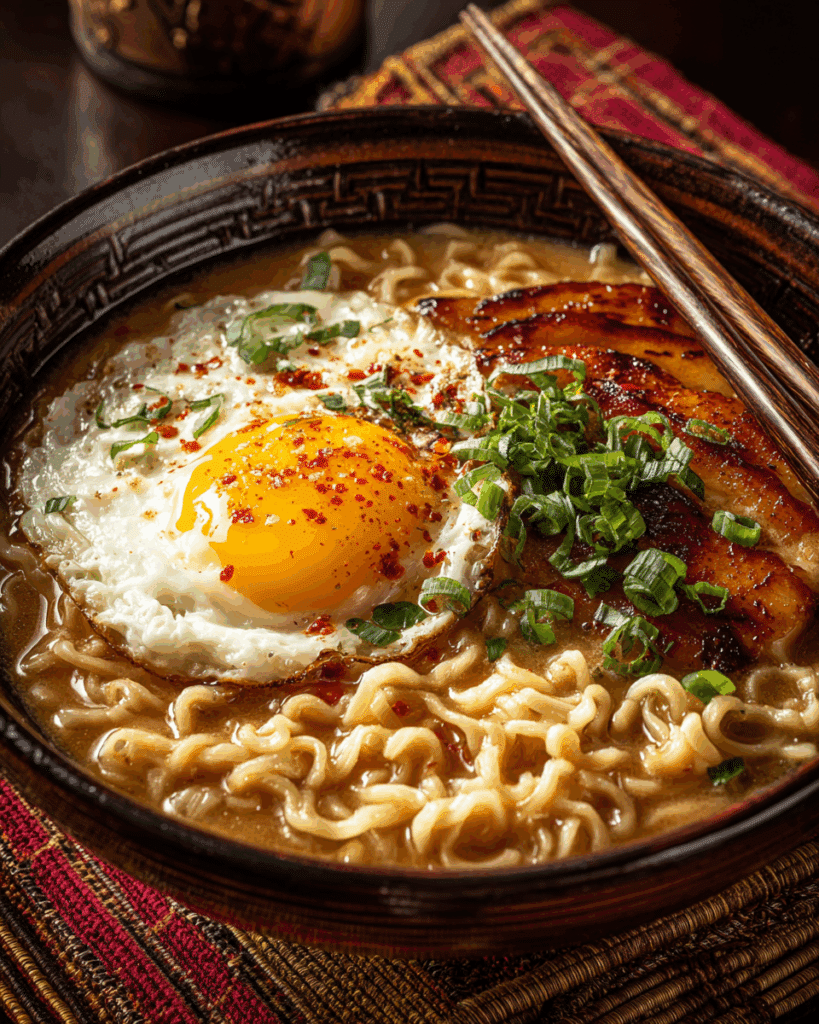
When you fall in love with Thai Peanut Butter Ramen, you will probably start craving it often, and sometimes you will want it ready faster than you can cook it from scratch. The good news is, this recipe is incredibly easy to make ahead, store, and even freeze if you plan it right. Thai Peanut Butter Ramen tastes just as amazing reheated the next day, and in some ways, the flavors even get stronger after they sit together overnight.
Make Ahead Tips
If you want to meal prep Thai Peanut Butter Ramen for busy days, the first thing to remember is to keep your noodles and sauce separate until you are ready to eat. The sauce, which includes coconut milk, peanut butter, curry paste, and seasonings, stores beautifully.
You can cook the sauce and chicken in advance and store it in an airtight container in the fridge for up to three days. When you are ready to eat, just boil fresh noodles, heat the sauce, and toss everything together. This keeps the noodles springy and prevents them from soaking up all the sauce while sitting in the fridge.
If you are really short on time during the week, you can even pre chop the vegetables. Slice the onion, carrot, and mushrooms, and keep them in small containers or zip bags in the refrigerator. When it is time to cook, everything goes straight into the pan in minutes. The goal is to make it so easy that cooking Thai Peanut Butter Ramen feels like just assembling your favorite comfort food.
Another little trick for make ahead Thai Peanut Butter Ramen is to prepare a jar of the peanut curry base. Combine coconut milk, red curry paste, peanut butter, and soy sauce in a small mason jar, and store it sealed in the fridge. When you are ready to cook, just pour it into a hot pot, add water, protein, and vegetables, and finish with noodles. Having this sauce pre mixed saves at least five minutes, and on busy nights that really helps.
Storage
Thai Peanut Butter Ramen stores very well in the fridge. Once it cools completely, transfer it to a sealed container. If the noodles are already mixed in with the sauce, they will keep for about two days before starting to get too soft. If you have the sauce and noodles separated, the sauce can last up to four days refrigerated. The flavor deepens over time, and the coconut milk and peanut butter blend even more smoothly.
When reheating, warm the sauce slowly on the stove over low heat, stirring often. If it thickened in the fridge, add a splash of water or coconut milk to loosen it. You can also reheat Thai Peanut Butter Ramen in the microwave in short bursts, stirring between each one to make sure it heats evenly. Just be careful not to overheat it, or the sauce might separate a little.
Freezing
Freezing Thai Peanut Butter Ramen is absolutely possible if you do it the right way. The trick is to freeze only the sauce, not the noodles. Noodles change texture when frozen and defrosted, becoming mushy. But the peanut coconut sauce freezes like a dream. You can make a big batch of the sauce, portion it into freezer-safe containers or bags, and label them. When you are ready for a quick meal, thaw a container in the fridge overnight, heat it up, and pour it over freshly cooked noodles and vegetables.
The frozen sauce will keep for up to two months. After that, it is still safe, but the flavor starts to fade a bit. So, if you love Thai Peanut Butter Ramen, make a few portions of sauce, freeze them, and you will always have a quick base for a weeknight meal.
Reheating for Best Flavor
When reheating Thai Peanut Butter Ramen, stir in a spoon of peanut butter or a small splash of coconut milk to bring the sauce back to life. The fat content helps revive the creamy consistency. You can also brighten it with a squeeze of lime or a pinch of chili flakes right before serving. Reheated Thai Peanut Butter Ramen often tastes richer and spicier than the first day, which makes it a great leftover meal for lunch.
Whether you meal prep it, store it, or freeze the sauce, Thai Peanut Butter Ramen remains one of those recipes that is as practical as it is delicious.
Common Mistakes to Avoid When Making Thai Peanut Butter Ramen
Even though Thai Peanut Butter Ramen is fairly simple to make, there are a few mistakes that can affect the final result. The good news is that once you know them, they are easy to avoid, and your noodles will come out perfect every time.
Mistake 1: Adding the noodles too early
This is one of the most common problems people run into when making Thai Peanut Butter Ramen. Instant ramen noodles cook incredibly fast, and if they sit too long in the hot peanut sauce, they will soak up all the liquid and become mushy. To fix this, always add the noodles near the end of cooking. Once the vegetables and chicken are cooked, toss in the noodles, stir gently, and cook just until they soften. Then remove the pot from heat right away.
Mistake 2: Using too much heat
Thai Peanut Butter Ramen depends on the delicate blend of coconut milk, peanut butter, and curry paste. If you boil it too hard, the sauce can separate and turn oily. The trick is to cook everything on medium heat, gently letting the ingredients melt together. When you see the oil start to rise slightly to the top, that means your curry paste is blooming correctly, and your flavor base is perfect. If it starts bubbling too rapidly, lower the heat. A calm simmer gives Thai Peanut Butter Ramen its creamy, unified texture.
Mistake 3: Skipping the taste test
One of the biggest secrets to good cooking is tasting as you go. The balance of flavors in Thai Peanut Butter Ramen sweet, spicy, salty, and nutty can shift depending on the brand of peanut butter or curry paste you use. Always taste your sauce before serving and adjust it. Add soy sauce if it needs more salt, a tiny pinch of sugar if it is too spicy, or a little extra peanut butter if it tastes thin. That way, your Thai Peanut Butter Ramen will always come out balanced.
Mistake 4: Forgetting the garnish
It might sound optional, but fresh garnish changes the entire experience. Without it, Thai Peanut Butter Ramen can feel heavy. With coriander, green onion, or even a few crushed peanuts, it tastes fresh and complete. Skipping this step is like leaving out the final touch that makes the bowl come alive.
Mistake 5: Overcrowding the pot
When cooking, it can be tempting to toss in everything at once, but crowding the pot prevents proper heat distribution. If your pan is too full, the vegetables and chicken may steam instead of sauté, which affects texture. To avoid this, use a medium-sized pot and give ingredients space. Let the chicken cook first until opaque, then add the vegetables, and finally the noodles. The layers build flavor as they cook.
By keeping these small details in mind, your Thai Peanut Butter Ramen will turn out creamy, flavorful, and restaurant-quality every single time. These mistakes are easy to make, but also easy to fix once you know what to watch for.
Cultural and Historical Background of Thai Peanut Butter Ramen
Even though Thai Peanut Butter Ramen sounds like a modern fusion idea, it actually represents a beautiful blend of traditional Thai flavors and global pantry staples. The concept of mixing peanut-based sauces with noodles has deep roots in Southeast Asian cuisine, and it has evolved through years of culinary adaptation.
In Thai cooking, peanuts and peanut sauces have been part of the culture for centuries, used in famous dishes like satay and certain noodle varieties. Peanut sauce in Thailand is often built from roasted peanuts, coconut milk, palm sugar, and curry paste, which are the same key flavors that make Thai Peanut Butter Ramen taste so authentic. The difference is that ramen brings a Japanese-style noodle texture into the picture, turning it into a perfect East-meets-East dish that feels familiar but new.
The popularity of Thai Peanut Butter Ramen exploded online, especially through viral videos on TikTok, where food lovers discovered how combining simple peanut butter and instant ramen could create something extraordinary. The internet trend inspired people to refine the concept, adding curry paste, coconut milk, and real Thai ingredients to make it taste closer to authentic Thai comfort food. Now, it is not just a viral hack but a proper dish in its own right.
In Thai cuisine, balance is everything. Sweet, salty, spicy, and creamy elements all need to play together. That is exactly what Thai Peanut Butter Ramen achieves. The coconut milk adds richness, the curry paste adds depth and heat, the peanut butter gives a nutty base, and the soy sauce rounds everything with savory umami.
The word “ramen” in this dish might sound Japanese, but it has been absorbed into Thai street food culture as well. Walk through Bangkok night markets, and you might see vendors offering spicy noodle soups that borrow the same instant noodle texture. Thai people have a long tradition of adopting ingredients and making them their own. Thai Peanut Butter Ramen is a perfect reflection of that spirit.
Today, this dish is loved by home cooks around the world. It appears in modern Thai cookbooks, on food blogs, and on restaurant menus as a cross-cultural comfort food. It embodies the idea that you can honor Thai flavors while still playing creatively with ingredients you already have in your kitchen. That is what makes Thai Peanut Butter Ramen special it connects traditional Thai cooking with modern simplicity.
Serving Suggestions for Thai Peanut Butter Ramen
Serving Thai Peanut Butter Ramen is honestly one of my favorite parts, because this dish can be dressed up to feel like a full dinner centerpiece, or it can just be served in a big personal bowl on the couch in the middle of the night. There is no wrong way. The point of Thai Peanut Butter Ramen is comfort, and comfort looks different depending on the day.
Let us start with texture. Thai Peanut Butter Ramen is rich and creamy, so pairing it with something fresh or crunchy on the side makes the meal feel balanced. A simple cucumber salad with a little rice vinegar, a squeeze of lime, and a pinch of salt is a perfect match.
The cool cucumber cuts through the creamy coconut milk and peanut butter base in Thai Peanut Butter Ramen. You could also add fresh herbs to that salad, like cilantro or mint, to echo the garnish in the ramen so the whole meal feels connected.
You can also serve Thai Peanut Butter Ramen with lightly steamed or sautéed greens. Baby bok choy, spinach, or snap peas work beautifully. The thing about Thai Peanut Butter Ramen is that the sauce is bold. The noodles, chicken, and mushrooms soak up that sauce. So serving a simple side of lightly salted greens gives a mellow, clean contrast. You can spoon a little of the Thai Peanut Butter Ramen sauce over those vegetables too, and it will taste like something from a noodle shop.
If you like eggs with your ramen, you can absolutely turn Thai Peanut Butter Ramen into a full, filling bowl by adding a jammy egg on top. Boil an egg for about seven minutes, then place it in ice water, peel, and slice it in half over the bowl right before serving. The yolk is soft and velvety, and it melts into the broth.
This trick makes Thai Peanut Butter Ramen feel more satisfying and almost a little luxurious. Another way to use egg in Thai Peanut Butter Ramen is to crack a raw egg straight into the hot pot right after you turn off the heat. Stir fast. The egg will cook gently and give the broth a silky finish, kind of like egg drop soup energy.
For toppings, do not hold back. Thai Peanut Butter Ramen loves texture. Crushed roasted peanuts, chili crisp oil, toasted sesame seeds, fried shallots, or crispy garlic bits all make the bowl taste layered and complete. Coriander and green onion are already classic garnishes in Thai Peanut Butter Ramen, but if you also add a squeeze of fresh lime juice or even a few ribbons of raw carrot or cucumber on top, the bowl pops with brightness. That nice balance of fresh and rich is what makes Thai Peanut Butter Ramen so addictive.
You can also turn Thai Peanut Butter Ramen into a bigger meal by pairing it with appetizers. Spring rolls or fresh summer rolls are amazing here. The fresh rolls with herbs and lettuce, sometimes shrimp or tofu, give you crunch and coolness.
When you eat that next to a warm spoonful of Thai Peanut Butter Ramen, it feels like a perfect dinner you would get at a Thai fusion spot. If you want something more cozy, try serving Thai Peanut Butter Ramen with pan fried dumplings. Dumplings dipped in a little soy sauce and chili paste next to that creamy peanut ramen is very comforting.
For drinks, a cold drink goes really well with Thai Peanut Butter Ramen, especially if you went spicy. I love the idea of pairing Thai Peanut Butter Ramen with iced tea sweetened just slightly with honey, or a light ginger lime sparkling drink, or even Thai style iced tea if you want something sweeter. The sweetness and the chill help balance the heat from the red curry paste in the Thai Peanut Butter Ramen broth. If you like citrus, a cold lime soda style drink cuts through the richness of the coconut milk and peanut butter. That contrast is so satisfying.
Serving style also matters. If you want Thai Peanut Butter Ramen to feel more like a main event, serve it in a deep wide bowl and let the noodles sit in the center with the chicken and vegetables neatly layered along one side, then garnish in sections. Put mushrooms in one visible spot, carrots in another, chicken fanned out a little, and the soft boiled egg halves right on top. Finish with coriander and green onion. This restaurant style plating makes Thai Peanut Butter Ramen feel thoughtful and intentional. It is also perfect if you are cooking for someone and you want to impress them but still keep things cozy and comfortable.
If you are feeding a group or doing a little family style dinner, you can double the recipe and serve Thai Peanut Butter Ramen in a large pot in the middle of the table. Put out small bowls of toppings like chopped coriander, sliced green onions, crushed peanuts, chili flakes, and lime wedges.
Let everyone build their own final bowl of Thai Peanut Butter Ramen. This is not just fun but also practical because everyone likes a different spice level and texture. You will notice that some people will drown their Thai Peanut Butter Ramen with lime, some people will load peanuts, and some will go heavy on heat with chili oil. This kind of flexible meal always makes people happy.
One more serving suggestion that people love. You can turn leftover Thai Peanut Butter Ramen into a next day lunch wrap. Drain some of the noodles and chicken so they are not too saucy, layer them in a warm tortilla with some crunchy slaw or shredded lettuce, add a few cucumber strips and a drizzle of sriracha, and roll it up. It sounds a little funny, but it tastes like a spicy Thai peanut chicken wrap, and it is honestly fantastic. This is a really good trick for turning Thai Peanut Butter Ramen leftovers into something portable for work or school.
So, whether you enjoy Thai Peanut Butter Ramen in a quiet bowl alone on the couch at midnight, or you lay it out beautifully for guests, or you repurpose it into something creative the next day, this dish gives you options. That is part of the reason why Thai Peanut Butter Ramen is not just a recipe, but a go to meal plan.
Conclusion, and Why This Dish Keeps Winning
This recipe is one of those meals that quietly wins you over. You might make it once because it sounds unusual, or because you saw someone prepare a version online, or because a friend mentioned that peanut butter and noodles somehow work together. Then you try it, you take that first bite, and it suddenly becomes part of your regular dinner rotation. It is warm. It is creamy. It is a little spicy. It smells like coconut and curry and toasted peanuts, and it tastes like pure comfort.
What makes this recipe special is how practical it is. It comes together fast, in about twenty minutes from start to finish, which is perfect on a busy evening. It is also flexible. You can use chicken, shrimp, tofu, or whatever protein you have on hand. You can make it mild for a calm, family friendly meal or turn up the heat for a spicy, satisfying dinner. You can keep the texture thick like saucy noodles or make it looser like a cozy noodle soup. You can make it feel rich and indulgent with full-fat coconut milk, or lighten it with extra vegetables and a smaller spoonful of peanut butter. One basic method becomes countless personal versions.
This dish feels personal because it allows you to cook according to your taste. There is no strict rule for how it must turn out. That freedom makes it welcoming, especially for people still learning to cook. Along the way, you pick up essential kitchen skills like how to bloom curry paste in coconut milk, how to season with soy sauce instead of salt, and how to balance spicy, sweet, and savory flavors until they taste right to you. Learning those details builds confidence and opens the door to all kinds of Asian inspired cooking.
There is also an emotional side to this kind of comfort food. A warm bowl of creamy noodles with steam rising up can feel like a small act of kindness toward yourself after a long day. It is the kind of meal that makes you breathe slower and feel a little calmer while you eat. It is familiar, cozy, and grounding. That is why people return to this recipe again and again, teaching it to friends, passing it along, and adding their own touches every time.
If you enjoy cooking, or you are just starting out, this is a wonderful recipe to master. It is fast enough for a weeknight, cozy enough for a rainy evening, impressive enough for a relaxed at home date, and affordable enough for tight grocery weeks. You do not need fancy tools or advanced techniques to make it taste great. All it takes is a single pot, a few pantry staples, and a little patience.
So keep this one close. Stock your pantry with coconut milk and noodles, keep a jar of peanut butter ready, and tuck a bunch of green onions and coriander in your fridge. The next time you crave something warm, flavorful, and satisfying, you will have everything you need to bring together a bowl of creamy, comforting noodles that always feel like home.
FAQ
Can I use any instant noodles to make Thai Peanut Butter Ramen, or do I need a special Thai ramen noodles package?
You can use pretty much any instant noodles to make Thai Peanut Butter Ramen. You do not need a fancy Thai ramen noodles package for this recipe. The noodles are mainly here to deliver the creamy coconut peanut sauce. Just do not use the seasoning packet that comes with the noodles, since you are building your own sauce with peanut butter, coconut milk, soy sauce, curry paste, and seasoning powder.
If you ever want a slightly firmer bite, you can even use fresh or frozen ramen style noodles, or thin wheat noodles, or yakisoba style noodles. The important part is that you do not overcook them in the pot. Add them toward the end, let them soften, and pull the pot off the heat so the noodles in your Thai Peanut Butter Ramen stay bouncy and perfect.
How can I make Thai Peanut Butter Ramen spicy without ruining the flavor?
If you like heat, you can absolutely turn Thai Peanut Butter Ramen into a spicy peanut ramen noodles style bowl without losing the creamy texture. The best way is to add spice in layers instead of dumping a ton of chili all at once.
You can add a little extra red curry paste to the coconut milk at the start. You can mix in chili flakes or sambal while the broth simmers. Then you can finish the bowl with a drizzle of chili oil or chili crisp on top right before serving. This layered method keeps the flavor full and round, and it gives Thai Peanut Butter Ramen that slow building heat people love, instead of just making it harshly hot.
Is Thai Peanut Butter Ramen really Thai, or is it more of a fusion dish?
Thai Peanut Butter Ramen is a fusion style dish. It takes classic Thai flavors like coconut milk, red curry paste, soy sauce, and peanut, and blends them with instant ramen noodles which are usually associated with Japanese style ramen bowls and pantry friendly comfort food.
The flavor balance, which includes salty, sweet, spicy, and creamy notes, is true to Thai cooking style. The noodle choice is what leans it into fusion territory. So Thai Peanut Butter Ramen is not a strict traditional Thai recipe, but it is deeply Thai inspired in spirit and taste.
Can I make Thai Peanut Butter Ramen without chicken?
Yes, you can make Thai Peanut Butter Ramen without chicken. You can replace the chicken with tofu, tempeh, mushrooms, or even shrimp. Firm tofu works really well because it soaks up the coconut milk and peanut butter sauce, and it becomes flavorful and tender.
If you want a higher protein version of Thai Peanut Butter Ramen without meat, pan sear cubes of tofu first so they get a golden crust, and then add them to the broth at the end so they do not fall apart. You can also go vegetable heavy by doubling the mushrooms and adding baby bok choy or spinach. The flavor base of Thai Peanut Butter Ramen is strong enough that it does not rely on meat to taste satisfying.
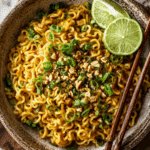
Thai Peanut Butter Ramen
- Prep Time: 5 minutes
- Cook Time: 15 minutes
- Total Time: 20 minutes
- Yield: 2 servings 1x
- Category: Main Course
- Method: Stovetop
- Cuisine: Thai Fusion
- Diet: Halal
Description
A creamy and spicy Thai-inspired noodle bowl made with coconut milk, red curry paste, and peanut butter. This quick and easy recipe combines tender chicken, fresh vegetables, and instant ramen noodles for a rich, comforting meal ready in just 20 minutes.
Ingredients
- 1/2 cup coconut milk
- 1/2 tbsp red curry paste
- 4 tbsp creamy peanut butter (see notes)
- 1 1/2 cups water
- 1 tbsp Rosdee seasoning powder (see notes)
- 1 tbsp light soy sauce
- 1/2 cup chicken, sliced thinly
- 1/4 cup onion, sliced thinly
- 1/4 cup carrot, sliced thinly
- 1/2 cup mushrooms (see notes)
- 1 pack instant ramen noodles
- 1 tbsp coriander, chopped (optional garnish)
- 1 green onion, chopped (optional garnish)
Instructions
- Heat a pot or wok over medium heat. Add the coconut milk, red curry paste, and peanut butter, stirring continuously until everything is well combined and fragrant. Wait until you see the natural oil from the coconut milk begin to appear.
- Pour in the water, soy sauce, and Rosdee seasoning powder. Stir well and bring the mixture to a gentle boil.
- Add the sliced chicken and cook until the meat is opaque and no longer pink.
- Add the onions, carrots, mushrooms, and dried ramen noodles. Stir and cook until the noodles are tender and the vegetables reach your preferred texture. Avoid overcooking to keep the sauce creamy.
- Serve hot, garnished with chopped coriander and green onions. Optionally, top with crushed peanuts or a drizzle of chili oil for extra flavor.
Notes
- If you cannot find Rosdee seasoning powder, substitute with chicken bouillon or mushroom seasoning.
- Natural peanut butter works well, but stir thoroughly to mix the oil before using.
- Full-fat coconut milk gives a richer, creamier result; light coconut milk can be used for a lighter version.
- Shiitake or oyster mushrooms add more depth of flavor compared to button mushrooms.
- Adjust spice level by increasing or reducing the amount of red curry paste.
Nutrition
- Serving Size: 1 bowl
- Calories: 550
- Sugar: 7g
- Sodium: 980mg
- Fat: 28g
- Saturated Fat: 11g
- Unsaturated Fat: 15g
- Trans Fat: 0g
- Carbohydrates: 45g
- Fiber: 4g
- Protein: 28g
- Cholesterol: 55mg
Keywords: Thai Peanut Butter Ramen, Peanut Butter Ramen, Spicy Thai Ramen, Coconut Milk Noodles, Easy Thai Dinner, Quick Ramen Recipe, Peanut Curry Ramen

